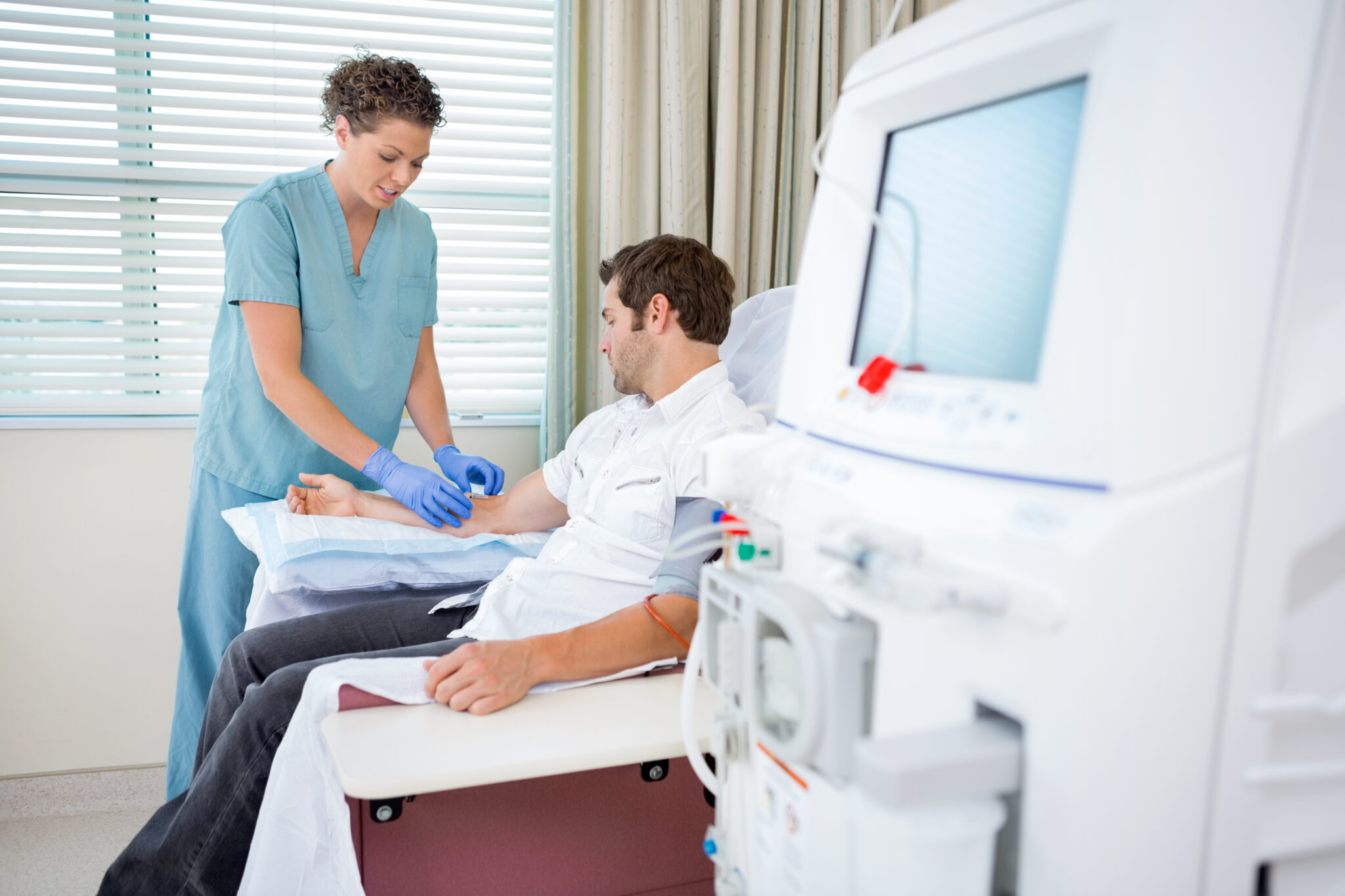Dietitian Blog | Jun 18 2024
Nutrition for CRRT

Continuous renal replacement therapy (CRRT) is often used for patients with acute kidney injury (AKI) in the ICU. CRRT can effectively treat hyperkalemia, uremia, hypotension, and volume overload while maintaining fluid homeostasis, electrolyte and acid-base balance, and providing greater clearance of nitrogen waste. Patients who require CRRT are the most critically ill and complex patients found in hospitals.
CRRT terminology
CRRT is the generic term that refers to any type of continuous renal replacement therapy. There are different types of CRRT such as CVVH, CVVHD, and CVVHDF.
The first letter describes duration.
- C = continuous
The next two letters describe where the blood is taken from and returned.
- AV = artery to vein.
- VV = vein to vein, the preferred circuit in all US centers.
The final letters describe which method of solute removal is used.
- HD = hemodialysis relates to diffusion.
- H or HF = hemofiltration, which is convection.
- HDF combines both diffusion and convection.
Dialysate: Fluid used for solute exchange to eliminate toxins and waste
Replacement fluids: Replaces lost electrolytes, blood volume and other blood elements lost during filtration with the dialysate
Effluent: Spent dialysate plus the volume of ultrafiltrate desired to achieve negative fluid balance

Energy needs during CRRT
Defining energy expenditure and optimal caloric needs for patients undergoing CRRT is challenging. Kidney injury does not cause a significant increase in energy expenditure, but physiological changes are present due to altered substrate digestion, absorption, and requirements in AKI. Critically ill patients are hypercatabolic and hypermetabolic with increased energy expenditures. Adequate calories are vital to thwart the breakdown of muscle for energy and to support the catabolic response while the acute conditions are controlled or resolved.
Although indirect calorimetry is the gold standard to measure resting energy expenditure, measurements in patients on CRRT may not be accurate. The acid-base status is modulated by sodium bicarbonate containing fluids that may alter serum pCO2 levels and would affect measured O2 consumption rate. CRRT often induces hypothermia which further hampers measurement metrics. In lieu of indirect calorimetry, dietitians can estimate energy needs at approximately 25 to 35 kcals/kg.
Protein needs during CRRT
In critical illness, protein breakdown and synthesis occur at accelerated rates. Rapid, significant lean body mass loss leads to muscle weakness, decreased immunity, decreased protein synthesis, increased urea production, and insulin resistance. A positive nitrogen balance is associated with improved survival. CRRT has the distinct advantage of providing an environment where the volume of fluid infused and electrolyte concentration of the nutrition formulations are less crucial, and therefore delivery of adequate protein may be easier to achieve. Critically ill patients with AKI should avoid protein restrictions to delay initiation of dialysis.
All methods of dialysis cause activation of protein catabolism through loss of AA, release of cytokines causing inflammation and chronic blood loss. Studies confirm significant losses of measured amino acids from 5 to 20 g/day. The type of renal replacement therapy can determine percentage of protein losses with higher losses reported with CVVH. Protein recommendations are 1.5 to 2 g/kg to promote positive nitrogen balance with some studies suggesting intakes up to 2.5 g/kg may be needed.
Micronutrient losses during CRRT
Studies that have measured changes in blood trace elements most commonly report decreased levels of copper, selenium, and zinc over time. Interpretation of trace element blood level concentrations require CRP values during inflammation. Low copper levels, which are linked to ceruloplasmin, a positive acute phase reactant, always reflect deficiency.
Vitamin losses for the smaller sized water-soluble vitamins are greater and include thiamin, folate and vitamin C. In a critical care setting, levels of vitamins A and E seem to be lower and the activation of vitamin D3 is impaired during AKI. The four fat-soluble vitamins A, D3, E and K have not been detected in effluent fluid in research studies.
Micronutrient supplementation during CRRT
Expert opinion and the data from studies suggest that water-soluble vitamins should be administered routinely during CRRT. Levels of vitamins, copper and zinc should be monitored when CRRT lasts longer than 1 to 2 weeks. Recommendations should not be based on blood levels alone, which decrease during the acute phase response.
Clinical practice guidelines do not make specific recommendations for micronutrient supplementation due to low quality of existing data. Clinicians should be mindful of impaired kidney function before supplementing vitamins and trace elements. Small water-soluble molecules are lost during CRRT so repletion could be justified but controversy still exists about the optimal dosage, timing, and duration.
A CRRT cocktail has been hypothesized for all CRRT patients which includes: 100 mg thiamin, 200 mg pyridoxine, and 1 mg folate in 50 mL of 0.9% sodium chloride infused over 30 minutes at the start of CRRT and repeated every 48 hours while patients remain on CRRT. Again, more data are needed before specific recommendations can be made.
Special nutrition considerations
Glycemic control is paramount in the critically ill patient. Up to 40 to 80 g of glucose can be lost each day while on CRRT. Many dialysates or replacement solutions contain glucose, and it is important to consider the calories a patient will receive from the dialysate when planning the nutrition intervention.
Per 2016 ASPEN/Society of Critical Care Medicine Critical Care Guidelines, standard polymeric enteral formulas are first-line therapy for AKI and CRRT. If significant electrolyte abnormalities are present, a kidney-specific formula can be tried.
Dietitians On Demand is a nationwide staffing and recruiting company for registered dietitians, specializing in short-term, temporary and permanent-hire positions in acute care, long-term care and food service positions. We’re dedicated to dietitians and helping them enhance their practice and excel in the workplace. Check out our job openings, request your coverage, or visit our store today!
References
Kamel AY, Dave NJ, Zhao VM, Griffith DP, Connor Jr. MJ, Ziegler TR. Micronutrient alterations during continuous renal replacement therapy in critically ill adults: a retrospective study. Nutrition in Clinical Practice. 2018;33:439-446.
Berger M, Broman M, Forni L, Ostermann M, De Waele E, Wischmeyer PE. Nutrients and micronutrients at risk during renal replacement therapy: a scoping review. Current Opinion in Critical Care. 2021;27(4):367-377.
Saunders H. “Continuous Renal Replacement Therapy – StatPearls – NCBI Bookshelf.” National Center for Biotechnology Information, https://www.ncbi.nlm.nih.gov/books/NBK556028/. Accessed 17 Apr. 2024.
Maursetter L, Kight CE, Mennig J, Hofmann R Review of the mechanism and nutrition recommendations for patients undergoing continuous renal replacement therapy. Nutrition in Clinical Practice. 2011;26:382-390.
McClave SA, Taylor BE, Martindale RG, et al. Guidelines for the provision and assessment of nutrition support therapy in the adult critically ill patient. Journal of Parenteral and Enteral Nutrition. 2016;40(2):159-211.
Who we are
Dietitians On Demand is the nationwide leader in providing dietitians with jobs they love. If flexibility, competitive pay, a full benefits package, free CPEUs each month and a team dedicated to dietitians sound good to you, apply to our positions today.




